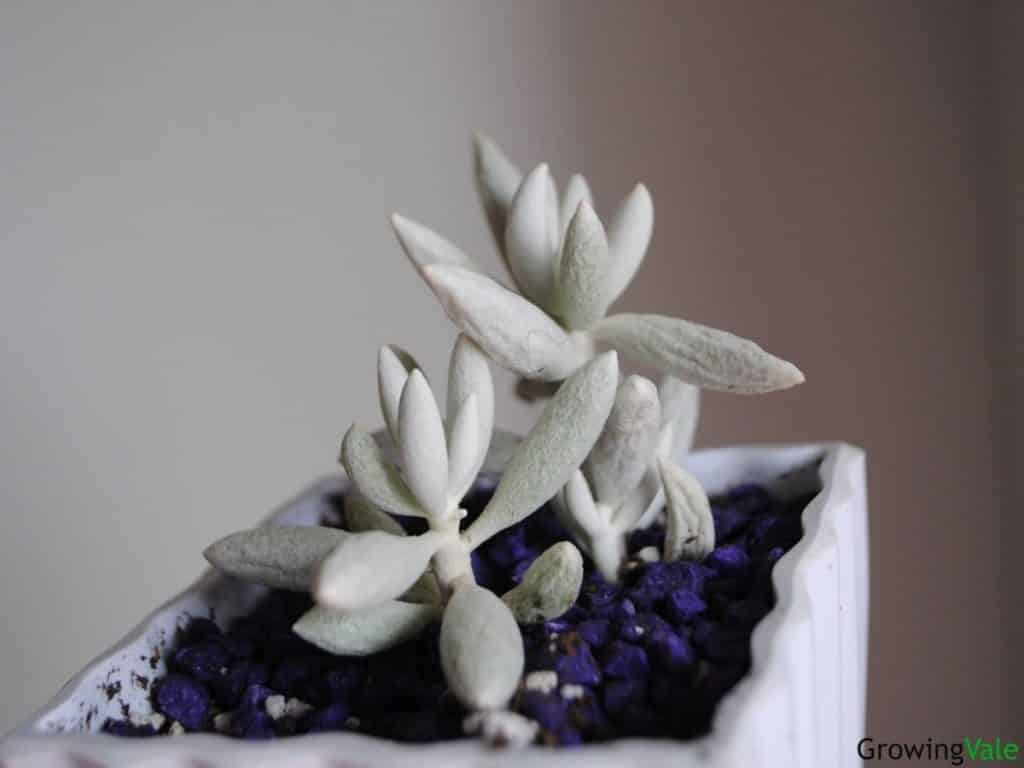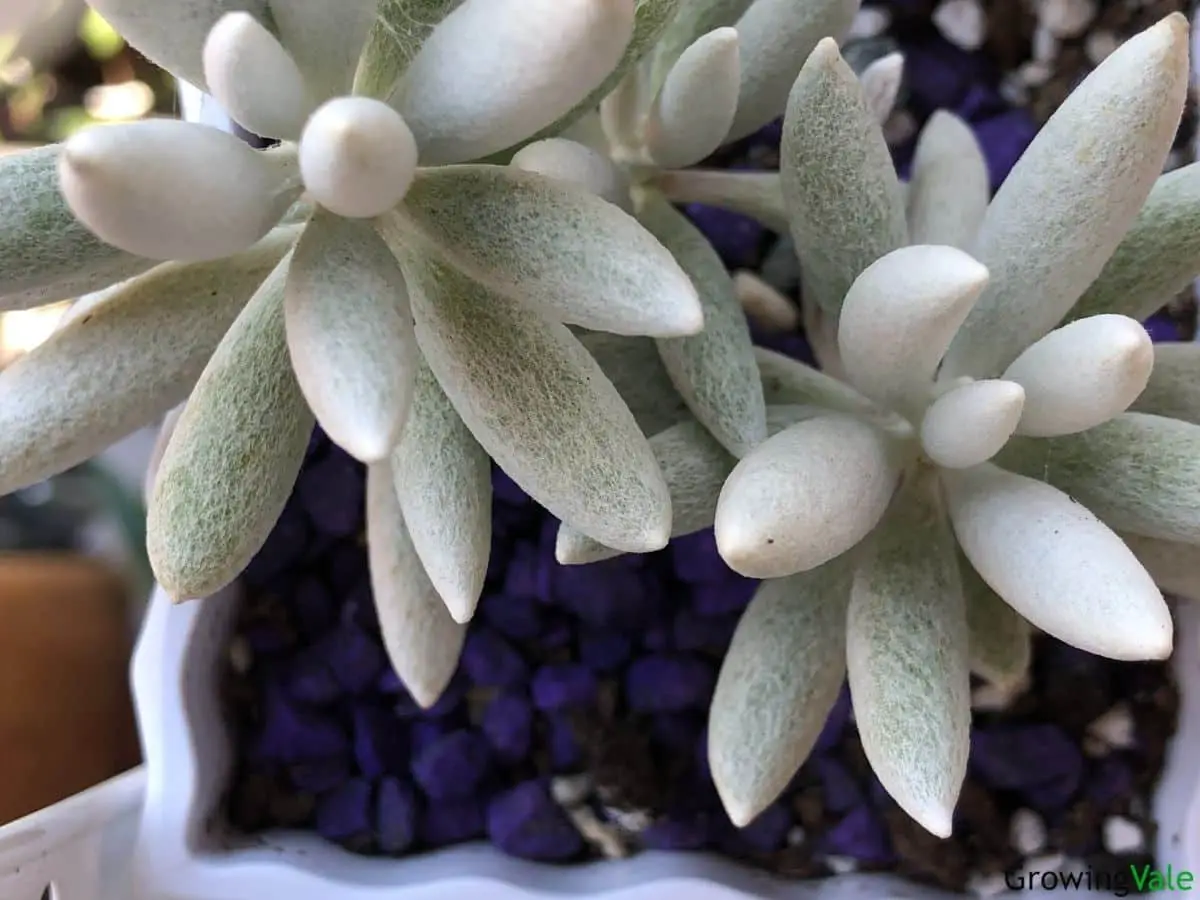The cocoon plant is a lovely succulent shrub that has woody stems with upright cylindrical leaves. These leaves grow in a loose whorl around the stem and appear as if they’re pure white. However, the color comes from the many fine white hairs that cover the surface of each succulent leaf.
This plant also produces bright yellow flowers that grow on short inflorescences at the terminal ends of the stems. However, these are not as spectacular as other succulent flowers and are far overshadowed by the lovely silvery-white leaves.
There’s a little confusion around the botanical name of this succulent plant as it was known as Senecio haworthii and is still often called that. However, according to some sources, this plant is apparently now known as Caputia tomentosa.
History
In South Africa, the cocoon plant is known as “Tontelbos” which means tinderbush. The locals would remove the white coating from the leaves and use it as tinder to start fires.
The plant was first identified by Adrian Hardy Haworth in 1803 in his dissertation called Miscellanea Naturalia. In this dissertation, Haworth explained that he was first introduced to the plant 8 years previous by his friend Benjamin Robertson. Haworth referred to the cocoon plant as Cacalia tomentosa.
Plant Facts
| Scientific name | Senecio haworthii (also known as Caputia tomentosa) |
| Common names | Cocoon plant, Woolly senecio, Wooly Senecio, Matted Caputia |
| Genus | Senecio or Caputia |
| Family | Asteraceae |
| Height | 1 foot |
| Width | 2 feet |
| USDA Plant Hardiness Zone | 9b to 11b |
| Origin | South Africa |
| Flower colors | Bright yellow |
| Blooming season | Winter to Summer |
| Plant/Flower special features | The leaves are covered with tiny white hairs which gives them a lovely white glow. |
How to Plant and Grow Cocoon Plant
The cocoon succulents can be grown outdoors in a sheltered spot that gets around 6 hours of morning sunlight. However, the plant is not frost-tolerant so it is best grown in a pot and moved inside during the colder weather.
How to Propagate Cocoon Plants
You can propagate Senecio from both stem cuttings and leaves. However, you should get faster results if you propagate Senecio haworthii using stem cuttings. Here’s what to do:
- Cut off a piece of stem using a pair of scissors or a clean, sharp knife.
- Leave the cutting in a dry spot for several days until the cut end callouses over.
- Place the cutting in a small pot filled with a succulent mix.
- Only water the cutting when the potting soil is completely dry.
And, here’s how to propagate the cocoon plants from leaves:
- Gently twist a leaf or two from the stem.
- Leave these in a dry place for several days until they form callouses.
- Place the leaves, cut side down into a small pot filled with a succulent mix.
- Only add water when the soil has become dry.
This succulent species can also be grown from seeds but these might take some time to germinate. The seeds need warm temperatures and constant moisture for optimum germination.

Care and Maintenance
Senecio haworthii is an easy plant to grow and requires minimal maintenance. The most important thing to remember is not to overwater it and to ensure it gets around 6 hours of bright, indirect sunlight on a daily basis.
Soil
If growing your Senecio in a pot, you should use an open, well-draining soil or succulent mix. You can also make your own mix by mixing equal parts of potting mix with perlite and coarse sand.
Remember that this plant doesn’t like to sit in water so it’s extremely important that the soil drains really well to avoid root rot.
If you live in a temperate climate, you can plant your Senecio outside but it needs to be in well-drained sandy soil. The soil should also not contain too much organic matter as this can cause leggy growth. Therefore, rock gardens that are mulched with pebbles or stones work well for this plant.
Water
The cocoon plant is very drought tolerant. It does require some water during its growing season but you should only water when the soil is completely dry both in summer and winter. It’s also most important that the plant is not allowed to sit in water at all.
To test if your plant actually needs water, give the leaves a very gentle squeeze. If the leaves are firm, then the plant doesn’t need any additional water just yet because the leaves are still holding adequate moisture.
However, if you notice that the leaves are a little droopy and starting to shrivel, it’s definitely time to give your plant a drink. Make sure you give your plant a thorough soak but ensure that all the excess water is allowed to drain away.
Fertilizer
You only need to fertilize this plant sparingly once a year in spring, as too much fertilizer is likely to cause the plant to become leggy. You can purchase a special fertilizer that is designed just for succulents. If you can’t find this, then a water-soluble fertilizer is fine as long as you use it at half strength.
Sunlight
When grown outdoors, the cocoon plant prefers full sun in the morning. It requires around four to six hours of sunlight daily. When you have your plant indoors, place it near a south or west-facing window.
If your cocoon plant doesn’t receive enough sunlight it will start to become quite leggy. Therefore, if it’s fairly dark in your house during winter, consider placing your Senecio under a grow light for a few hours a day.
Temperature and Humidity
In the summertime, these plants actually enjoy being outdoors. But, wait until all danger of frost is over before putting them out in a spot that receives morning sun and afternoon shade. Remember to bring your plants back indoors in the fall.
Outdoor temperature ranges from 25 to 30 degrees Fahrenheit (-6 to -1 degrees Celsius) are quite tolerable as long as the plant is in a sheltered spot and not exposed to frost or moisture. However, it’s much more desirable to bring your Senecio indoors during the cold season.
Pruning
Sometimes, the tall stems of this plant can tend to flop over. These stems can be pruned back to where the stem is quite firm and upright. Don’t throw away the bits you’ve pruned off because you can use these to easily propagate some new plants.
Repotting
To allow your cocoon plant to grow to its full potential, it might be necessary to repot every couple of years so that it has more room to spread. When you do this, just choose a new pot that’s a size or two larger than the current one. Take care when moving the plant into the new container so that you don’t damage any of the stems.
If some stems do accidentally fall off, just use these to propagate new plants.
Pest and diseases
The cocoon plant is relatively pest and disease-free. However, like other succulents, it might sometimes be attacked by common houseplant pests such as scale insects and mealybugs.
These are easily controlled by spraying the plant with diluted insecticidal soap or neem oil. You can also dab the offending insects with a cotton swab dipped in an isopropyl alcohol solution to kill them.
Uses of Cocoon Plant
Senecio haworthii is mainly used as an ornamental plant by succulent growers around the world. It looks particularly attractive when grouped in a shallow potting tray with other green succulents because the silvery-white leaves provide a lovely contrast.
Common Varieties and Cultivars
There are around 31 Senecio varieties commonly recognized. These include cascading plants, small shrubs, ground covers, and upright snake-like plants. Some common cultivars are:
- Senecio radicans (String of bananas or Fish hooks)
- Senecio peregrinus (String of dolphins)
- Senecio rowleyanus (String of pearls)
- Senecio herreanus (String of tears)
- Senecio kleiniiformis (Spear head)
- Senecio macroglossus
- Senecio jacobsenii
- Senecio anteuphorbium
- Senecio barbertonicus
- Senecio cephalophorus
- Senecio crassissimus
- Senecio decaryi (Madagascar senecio)
- Senecio scaposus ‘Silver Coral’
- Senecio scaposus var. addoensis
- Senecio mandraliscae (Blue chalk sticks)
- Senecio serpens
- Senecio articulatus (Candle plant)
- Senecio stapeliiformis
Conclusion
The Senecio haworthii cocoon plant is a sweet little succulent to add to your collection. It can provide quite a contrast with its lovely silvery-white upright leaves. This plant is relatively easy to grow and doesn’t require any special care.
See more string of plants and hanging succulents you can grow.

